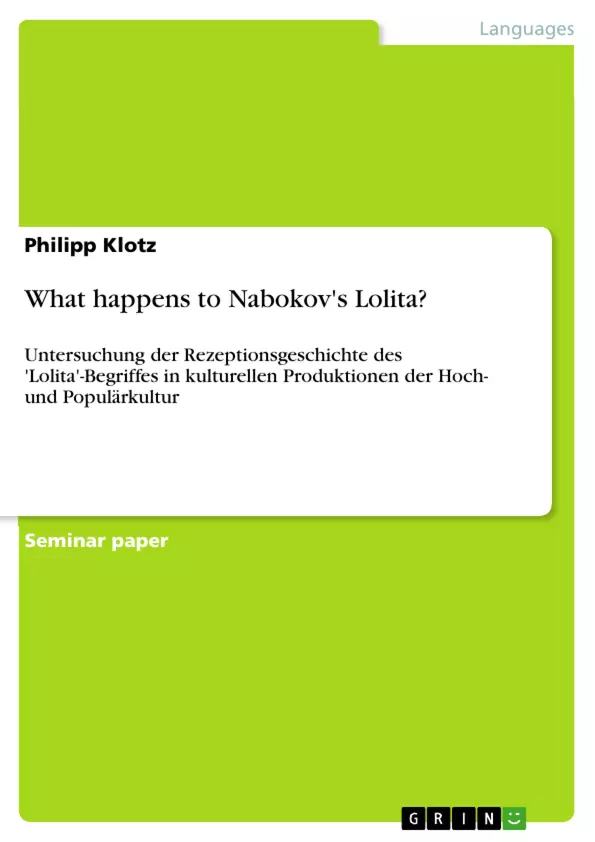Die vorliegende Arbeit widmet sich der Rezeptionsgeschichte des Begriffes der 'Lolita' in Produktionen der Hoch- sowie der Populärkultur.
Table of Contents
- Introduction
- Who is Nabokov's Lolita?
- Aim, Problems and Method
- Approximation on Lolita
- What happens to Nabokov's Lolita?
- Theoretical Basis
- Alizée: "Moi... Lolita"
- Rodion Shchedrin: Lolita
- Conclusion
Objectives and Key Themes
This paper aims to analyze the reception of Lolita's image in popular culture, contrasting it with a more nuanced interpretation. It examines how different adaptations of Nabokov's novel portray Lolita and her relationship with Humbert Humbert, focusing on the divergence between a superficial, seductive portrayal and a more complex, multi-layered understanding.
- The multifaceted nature of Lolita's character in Nabokov's novel.
- The reliability of Humbert Humbert's narrative and its impact on interpreting Lolita.
- A comparison of Lolita's portrayal in popular culture (Alizée's "Moi... Lolita") and high art (Shchedrin's opera).
- The concept of "misreading" Nabokov's novel in popular interpretations of Lolita's image.
- The significance of different cultural contexts in shaping the interpretation of literary characters.
Chapter Summaries
Introduction: This introductory chapter sets the stage for the analysis by highlighting the multifaceted nature of Nabokov's *Lolita* and its susceptibility to varied interpretations. It emphasizes the frequent misinterpretations of Lolita's character in popular culture and foreshadows the paper's focus on contrasting interpretations in a pop song and an opera. The chapter introduces the central thesis: that popular culture misreads Lolita's image, while high art offers a more nuanced understanding.
Who is Nabokov's Lolita?: This chapter delves into the complexities of Lolita's character as presented in Nabokov's novel. It grapples with the inherent challenge of interpreting her through the unreliable lens of Humbert Humbert's narration. The chapter explores different facets of Lolita's personality, questioning whether she is a seductive child, an innocent victim, or something more complex. The discussion highlights the difficulty in establishing a definitive characterization due to the narrator's subjective perspective and unreliable reporting of events. It establishes the methodological approach for the subsequent analysis, focusing on key scenes and Humbert Humbert's internal monologues to reconstruct a more complete picture of Lolita, acknowledging the limitations of this approach.
Keywords
Vladimir Nabokov, Lolita, character analysis, unreliable narrator, popular culture, high art, Alizée, "Moi... Lolita," Rodion Shchedrin, opera, misinterpretation, literary adaptation, child sexuality, pedophilia.
Frequently Asked Questions: Analysis of Lolita's Image in Popular Culture
What is the main topic of this academic paper?
This paper analyzes the reception of Lolita's image in popular culture, comparing it to a more nuanced interpretation found in high art. It focuses on how different adaptations of Nabokov's novel portray Lolita and her relationship with Humbert Humbert, highlighting the discrepancy between superficial and complex understandings of her character.
What are the key themes explored in the paper?
The paper explores the multifaceted nature of Lolita's character in Nabokov's novel; the reliability (or unreliability) of Humbert Humbert's narrative and its impact on interpreting Lolita; a comparison of Lolita's portrayal in popular culture (Alizée's "Moi... Lolita") and high art (Shchedrin's opera); the concept of "misreading" Nabokov's novel in popular interpretations; and the significance of different cultural contexts in shaping the interpretation of literary characters.
Which specific examples of popular culture and high art are analyzed?
The paper uses Alizée's song "Moi... Lolita" as an example of popular culture's portrayal of Lolita, and Rodion Shchedrin's opera adaptation as an example of high art's interpretation. The contrast between these two adaptations forms a central part of the analysis.
What is the methodology used in this analysis?
The paper examines key scenes and Humbert Humbert's internal monologues in Nabokov's novel to try and reconstruct a more complete picture of Lolita, acknowledging the inherent limitations of interpreting her through the unreliable narrator. It then contrasts this with the portrayals in the chosen popular culture and high art examples.
What is the central argument or thesis of the paper?
The central argument is that popular culture often misinterprets and simplifies Lolita's character, presenting a superficial and seductive image, while high art offers a more complex and nuanced understanding of her.
What are the key chapters and their summaries?
The paper includes an introduction setting the stage and outlining the thesis; a chapter analyzing Lolita's character in Nabokov's novel and the challenges of interpreting her through Humbert Humbert's perspective; and a conclusion. The analysis of "Moi... Lolita" and Shchedrin's opera is integrated within these chapters.
What are the keywords associated with this research?
Key words include Vladimir Nabokov, Lolita, character analysis, unreliable narrator, popular culture, high art, Alizée, "Moi... Lolita," Rodion Shchedrin, opera, misinterpretation, literary adaptation, child sexuality, and pedophilia.
- Arbeit zitieren
- Philipp Klotz (Autor:in), 2011, What happens to Nabokov's Lolita?, München, GRIN Verlag, https://www.grin.com/document/189295



